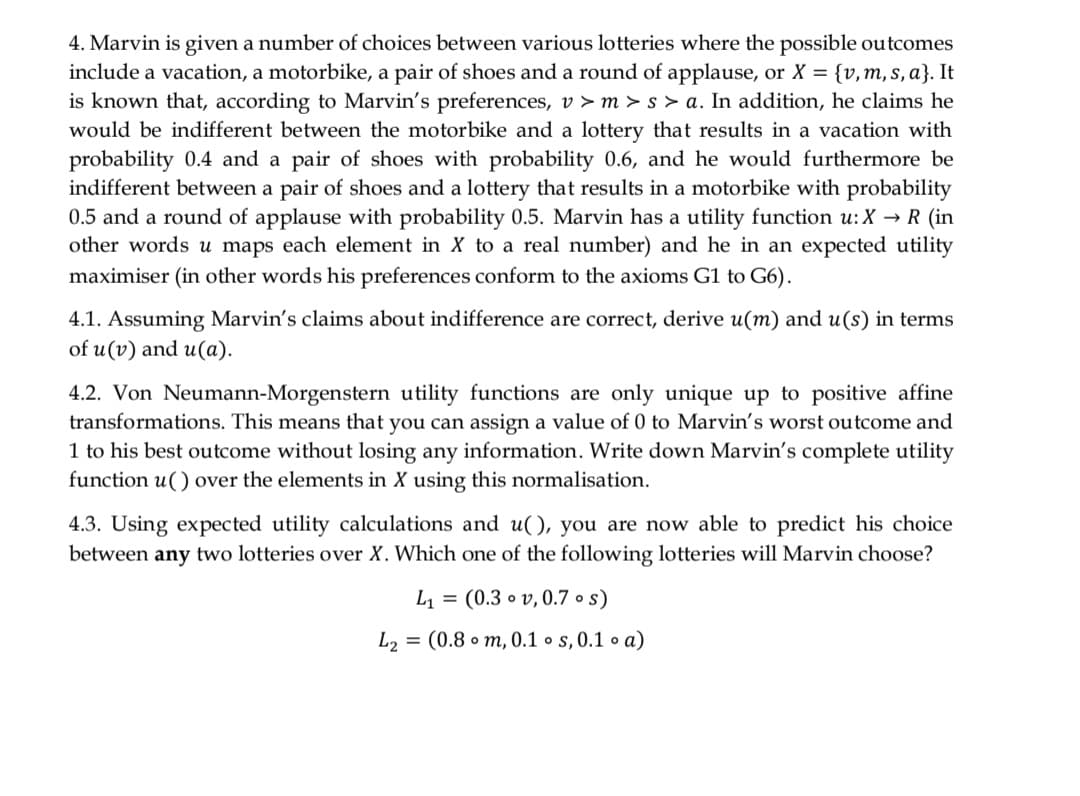4. Marvin is given a number of choices between various lotteries where the possible outcomes include a vacation, a motorbike, a pair of shoes and a round of applause, or X = {v, m, s, a}. It is known that, according to Marvin's preferences, v > m > s > a. In addition, he claims he would be indifferent between the motorbike and a lottery that results in a vacation with probability 0.4 and a pair of shoes with probability 0.6, and he would furthermore be indifferent between a pair of shoes and a lottery that results in a motorbike with probability 0.5 and a round of applause with probability 0.5. Marvin has a utility function u: X R (in other words u maps each element in X to a real number) and he in an expected utility maximiser (in other words his preferences conform to the axioms G1 to G6). 4.1. Assuming Marvin's claims about indifference are correct, derive u(m) and u(s) in terms of u(v) and u(a). 4.2. Von Neumann-Morgenstern utility functions are only unique up to positive affine transformations. This means that you can assign a value of 0 to Marvin's worst outcome and 1 to his best outcome without losing any information. Write down Marvin's complete utility function u() over the elements in X using this normalisation. 4.3. Using expected utility calculations and u(), you are now able to predict his choice between any two lotteries over X. Which one of the following lotteries will Marvin choose? L1 = (0.3 o v, 0.7 o s) %3D L2 = (0.8 o m, 0.1 • s, 0.1 • a)
4. Marvin is given a number of choices between various lotteries where the possible outcomes include a vacation, a motorbike, a pair of shoes and a round of applause, or X = {v, m, s, a}. It is known that, according to Marvin's preferences, v > m > s > a. In addition, he claims he would be indifferent between the motorbike and a lottery that results in a vacation with probability 0.4 and a pair of shoes with probability 0.6, and he would furthermore be indifferent between a pair of shoes and a lottery that results in a motorbike with probability 0.5 and a round of applause with probability 0.5. Marvin has a utility function u: X R (in other words u maps each element in X to a real number) and he in an expected utility maximiser (in other words his preferences conform to the axioms G1 to G6). 4.1. Assuming Marvin's claims about indifference are correct, derive u(m) and u(s) in terms of u(v) and u(a). 4.2. Von Neumann-Morgenstern utility functions are only unique up to positive affine transformations. This means that you can assign a value of 0 to Marvin's worst outcome and 1 to his best outcome without losing any information. Write down Marvin's complete utility function u() over the elements in X using this normalisation. 4.3. Using expected utility calculations and u(), you are now able to predict his choice between any two lotteries over X. Which one of the following lotteries will Marvin choose? L1 = (0.3 o v, 0.7 o s) %3D L2 = (0.8 o m, 0.1 • s, 0.1 • a)
Principles of Economics 2e
2nd Edition
ISBN:9781947172364
Author:Steven A. Greenlaw; David Shapiro
Publisher:Steven A. Greenlaw; David Shapiro
Chapter6: Consumer Choices
Section: Chapter Questions
Problem 1SCQ: Jeremy is deeply in love with Jasmine. Jasmine lives where cell phone coverage is poor, so he can...
Related questions
Question

Transcribed Image Text:4. Marvin is given a number of choices between various lotteries where the possible outcomes
include a vacation, a motorbike, a pair of shoes and a round of applause, or X = {v,m, s, a}. It
is known that, according to Marvin's preferences, v > m > s > a. In addition, he claims he
would be indifferent between the motorbike and a lottery that results in a vacation with
probability 0.4 and a pair of shoes with probability 0.6, and he would furthermore be
indifferent between a pair of shoes and a lottery that results in a motorbike with probability
0.5 and a round of applause with probability 0.5. Marvin has a utility function u: X → R (in
other words u maps each element in X to a real number) and he in an expected utility
maximiser (in other words his preferences conform to the axioms G1 to G6).
4.1. Assuming Marvin's claims about indifference are correct, derive u(m) and u(s) in terms
of u(v) and u(a).
4.2. Von Neumann-Morgenstern utility functions are only unique up to positive affine
transformations. This means that you can assign a value of 0 to Marvin's worst outcome and
1 to his best outcome without losing any information. Write down Marvin's complete utility
function u() over the elements in X using this normalisation.
4.3. Using expected utility calculations and u(), you are now able to predict his choice
between any two lotteries over X. Which one of the following lotteries will Marvin choose?
L = (0.3 o v, 0.7 • s)
L2 = (0.8 • m, 0.1 • s, 0.1 • a)
Expert Solution
This question has been solved!
Explore an expertly crafted, step-by-step solution for a thorough understanding of key concepts.
Step by step
Solved in 3 steps

Knowledge Booster
Learn more about
Need a deep-dive on the concept behind this application? Look no further. Learn more about this topic, economics and related others by exploring similar questions and additional content below.Recommended textbooks for you

Principles of Economics 2e
Economics
ISBN:
9781947172364
Author:
Steven A. Greenlaw; David Shapiro
Publisher:
OpenStax


Principles of Microeconomics
Economics
ISBN:
9781305156050
Author:
N. Gregory Mankiw
Publisher:
Cengage Learning

Principles of Economics 2e
Economics
ISBN:
9781947172364
Author:
Steven A. Greenlaw; David Shapiro
Publisher:
OpenStax


Principles of Microeconomics
Economics
ISBN:
9781305156050
Author:
N. Gregory Mankiw
Publisher:
Cengage Learning